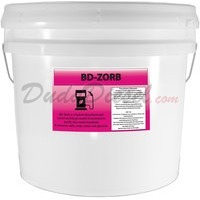Raw BD-Zorb Material
Biodiesel Purification Media
The Raw BD-zorb Material is made of highly refined wood chips, derived form hard wood and completely dry so it is able to remove soaps from biodiesel. Small dust and other ineffective materials have been sifted and removed from the material so that 100% of the media will absorb large amounts of soap from the biodiesel.
The normal BD-Zorb, is the same high quality material with 12% of the DudaLite DW-R10 added into it. If you are using DW-R10 for a final polish after using the Raw BD-zorb, the Resin mixed into the BD-zorb is not necessary.
BD-Zorb is a hybrid absorbent and cation exchange media formulated to purify (dry-wash) biodiesel. It removes salts, soap, water, and glycerin. It is commonly utilized as a "first step" purification in a two-part process of purifying biodiesel. Our DudaLite Ion-Exchange resin, also known as DW-R10, is used as the "second step" in the process. BD-Zorb has a high capacity for soap. Consequently, it will extend the life of the DudaLite DW-R10. It is important to remove as much methanol as possible prior to processing with BD-Zorb.
Advantages of using BD-Zorb
| Lowest use cost |
Lowest price per pound, high capacity |
Reduces effluent costs |
Can reduce or replace water wash |
Simple |
Media is easy to install and remove |
Easy to set-up |
Use formula to match exchange vessel dimensions to desired flow rates |
Easy to control |
set flow within your range |
Easy to monitor |
Simple tests to gauge performance (see monitoring guidelines) |
Physical Properties
| Appearance |
Granular with wide range of particle sizes |
Color |
Tan to light brown |
Bulk Density |
20 lb per cubic foot (dry) / 2.7 lb per gallon. |
Application Guidelines
| How much biodiesel will one pound of BD-Zorb treat? |
One pound of BD-Zorb will treat 70 to 100 Gallons of biodiesel. (based on an average of 1500 ppm of hydrophilic contaminants) Results will vary based on level of impurities and flow rates. |
How many pounds of BD-Zorb are required? |
One pound of BD-Zorb is required for every gallon per hour of biodiesel flow. |
How do I size/design exchange vessels? |
Use a minimum bed depth of 48 inches and a maximum 72 inches. The diameter should be based on the desired throughput per hour with consideration of the rate of one pound of BD-Zorb per gallon of biodiesel flow. |
| How do I know when my BD-Zorb is exhausted? |
Monitor soap levels, pressure drop and turbidity. |
| What are the safety considerations? |
First, you must read the MSDS before handling the product. Remember to protect yourself from wood dust. Dust can explosive with an ignition source. The spent media cannot be composted. |


